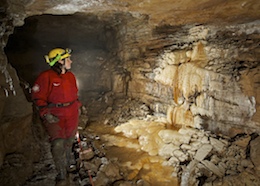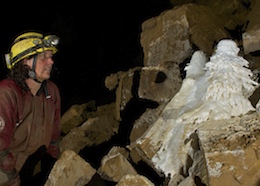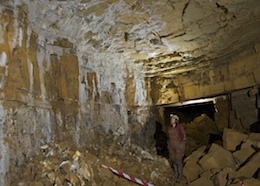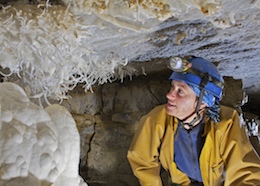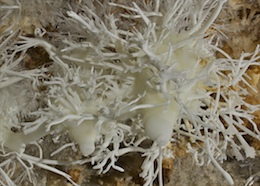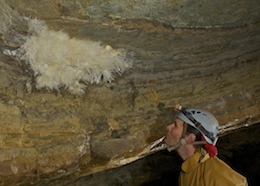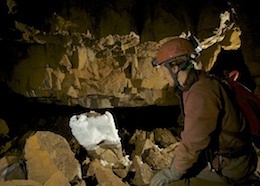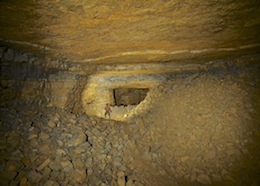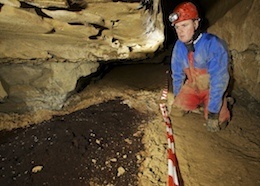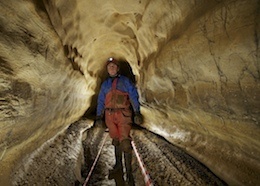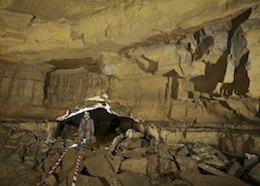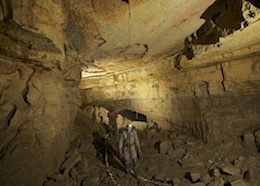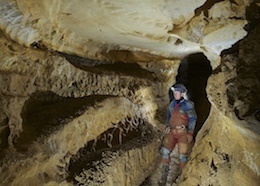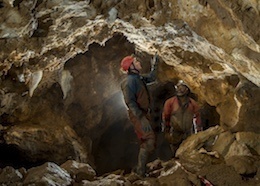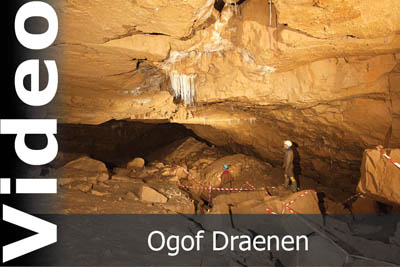Overview
Ogof Draenen is one of the largest cave systems in the country and through the sporting entrance series offers a wide variety of trips. Length 70,000m+
Altitude 362m
Grid SO 24644 11787
History
Ogof Draenen was originally a short section of cave that draughted very well. This was first dug by Cwmbran Caving Club in the mid 1980s and then continued by the Brynmawr Caving Club in the late 1980s. In early 1992 it was picked up by Morgannwg Caving Club as their regular Thursday night dig. In 1994 after nearly three years of persistent digging the team with core members of Peter Bolt, Ali Garman, Ben Lovett, Tim Long, Huw Jones and Kevin Munn broke through into open passage. Exploration continued at a fantastic pace over the next four years to reveal the extensive network of cave passage that is known today.
Location
To the west of the Pwll Du Adventure centre a footpath leads down to the stream and then crosses it before heading around a spoil heap. After crossing a fence the path descends steeply down a grassy hillside to end at the gated entrance to the cave amongst a group of hawthorn bushes. Clydach Gorge Google map showing the location of Ogof Draenen and other caves in the area.
Location map - click marker to show entrance photo
Access
The cave is gated for conservation reasons. Permits for access and keys are available from the Pwll Du Cave Management Group
Description
The cave has a sporting entrance series leads into a network of massive fossil passages. The system is far too vast and complex to begin to describe here, but a on the following page you will find a fully detailed Ogof Draenen description. A brief summary of major areas of the cave follows.The entrance series leads via a rope climb to Cairn Chamber where the log book should be filled out on your trip into the cave. This is the start of the major cave passages, to the left here leads past the bottom of Big Bang Pitch, the original way in via some very large boulder strewn passages. This leads past a shower inlet to a stream that can be followed upstream via a sporty waterfall climb to the Waterfall Series. This is very pleasant caving in more regular sized scalloped passages passing numerous gypsum formations on the walls as you approach Knees Up Mother Brown and then ends in Sixth Heaven Chamber with its fine aragonite formations. Going right at Cairn Junction leads to the Main Passage with its boulder strewn floor and several climbs that takes you to Tea Junction. An easier route is to head straight on from Cairn Chamber and go via Wonderbra Bypass to cut off a corner and meet the Main Passage further on. From the end of Wonderbra you can head right to Tea Junction and then ahead to the start of Gilwern Passage. Gilwern Passage leads to the Northern section of the cave located under Gilwern Hill. Heading downstream from near the start of Gilwern Passage leads via a couple of chokes to the Beyond A Choke Streamway, then to the end of the round trip. Following the streamway beyond this point leads eventually to Rifleman's Chamber and the current end of the streamway. From Cairn Chamber heading to the low crawls and Wonderbra Bypass the vast Main Passage is reached. This can be followed South to lead to a climb up through boulders and reach the impressive sized Lamb and Fox Chamber. Following the route through boulders to the top of the chamber leads to a staircase of rocks and the start of Indiana Highway. This long section of traverses is rigged with a traverse line and ends at a chamber with a route through to Megadrive. Megadrive leads on to the round trip and the South Eastern regions of the cave.
War of the Worlds
War of the Worlds is a very extensive and interesting area of the cave that is approached from Snowball Passage. It contains both the second largest chamber and the second largest passage in the entire cave.
War of the Worlds is approached from Snowball Passage either by Sleepcrawler crawls at the northern end of the Snowball or via a climb up through a choked area at the southern end of Snowball Passage. The usual route is the follow the slope up the choked passage on the left hand side near the southern end of Snowball Passage. Here a small hole is entered to drop down a slope into a large gypsum covered passage - the Black Run. This is followed until it reaches a choke where a low passage is leads off to the right and then to the left before reaching Red Chamber with it's deep red mineral coloured roof. At the other side of Red Chamber a series of low wide chambers containing piles of gypsum deposits on the floor are passed through until a choked end to the passage is reached. Here a hole through the boulders on the right drops down to enter a passage where the roof height soon increases and a chamber is reached with an oxbow from Red Chamber entering on the right, the way on being up a small boulder slope on the left to enter the start of Lost in Space. Lost in Space is over 750m in length and consists of a series of collapsed chambers each linked by squeezes or low crawls. At one point the passage appears to choke but going back 10m reaches a climb up in the roof and a small passage - Intergalactic Overdraught to regain the main passage beyond the choke. Just before a further choke is reached a boulder wall on the left directs you into Cold Fusion Passage which increases in size very quickly. Here a gypsum covered block - The Washing Machine is passed before a wide area containing formations is reached. Beyond the formations the passage is followed and quickly becomes very narrow until a point where a climb up reaches The Reactor, a huge chamber with a high fault controlled wall. The route from the Reactor is to head around to an alcove on the left where a steep descent down a loose boulder slope leads to a massive passage. This decreases in size until after about 100m a climb up over collapsed blocks and old formations reaches the site of an old camp. From here a narrow passage and traverses to the right lead to a large corner where the route passes over a large boulder and a climb down to a boulder slope beyond. Climbing up the boulder slope leads to a wide boulder strewn junction, with War of the Worlds South heading off to the right and the slightly smaller War of the Worlds North heading off to the left.
Raiders Passage
Raiders Passage provides an important winter bat roost as is evidenced by the piles of bat guano located in several areas of this and adjacent passages. This is a well formed passage, phreatic in origin along most of its length that can be followed for a considerable distance before it ends in sand fill. Along its length a fine selection of fossils are seen in the passage walls, many of these originate from the early ancestors of modern day sharks.
Raiders Passage should be avoided in the bat hibernation season and is entered as a low passage in the floor near the start of Indiana Highway. Here to the left the low passage heads off to emerge as a balcony overlooking Lamb and Fox Chamber. To the right the passage is followed as a low crawl, there are two passage on the left that link and end close to Canyon Passage. The main way is to carry on until the top of a 4m deep rift is reached. Climbing down into the rift it is followed for a short distance until it forms a roof and becomes a phreatic style passage up to 2m wide and continues for about 75m in this style until a sharp left hand corner is passed. Beyond this corner the passage is a little less well formed and short climbs or stoops are needed to make progress over the next 400m of passage. The passage displays a distinctive white colouration very similar to Indiana Highway and in several areas there are very bright orange deposits that fill narrow rifts. Through this section of passage many fossil pectoral and dorsal spines and gypsum "cornflakes" can be seen along here before the passage splits in two. There is a section of this passage where several large guano piles are seen below the low overhangs that provide the winter bat roosts.
The route splits, where to the right a low passage becomes flat-out before entering the other passage, which can be followed on the left via a narrow rift and a short climb. When the two passages rejoin, the phreatic style again takes over and the passage continues for a further 400m until it joins a larger passage. To the left closes down almost immediately, while to the right leads along an almost perfectly straight rift. The passage descends a little as a short side passage is passed before a hairpin bend swings off to the left. The passage now becomes noticeably phreatic and is encrusted with gypsum crystals in may areas until it appears to fill with mud. This can then be crawled over to access another section of large phreatic passage that ends after about 100m. Here a small crawl ahead leads to a dig in sandy fill. This was passed by Ali Garman and a couple of friends, between Christmas and New Year 94/95. The way into it is an upwards crawl, on the right, part way down the dig. This chamber is very different from the rest of the passage as it is formed in Dolomite and so named Dolomite Chamber. One of the roof tubes at the end gives a vocal connection between the two chambers.
A tube heading north was dug by Morgannwg and SWCC, enlarging the tube and passing a U bend to reach open passage. This was mostly digging and led to more small passages, perhaps 100m total in this section.
The Score
The Score was originally accessed from Over The Top in the Main Streamway and then Oo Crawl, but is now generally accessed from Back Passage which leads off from near Tea Junction.
The standard route into the Score is to enter Back Passage just upstream from Tea Junction. Here a short climb up reaches small passage on the right hand side of the Main Passage to enter a low crawl. This low crawl soon becomes tight and flat out over a dried mud floor that continues for 60m. Progress is quite tiring with the tightest sections being towards the end. The crawl ends at a dug out where you climb out into a chamber at the end of Crystal Cruncher Passage. From the Chamber an oxbow loops around on the left, while the way ahead is along some comfortable hands and knees crawls, with occasional sections of stooping. After 150m a passage leads off to a dig on the left while ahead some lower crawls continue to reach a right hand bend. A route to the right down a mud slope leads to a passage ending in boulder and mud fill, while ahead the passage continues as a low crawl for 25m to pass over a mud bank and enter the walking passage of The Score. This passage with walls covered in crystals is followed for 50m to reach the point where Oo Crawl enters on the right. Beyond this junction the passage size increases to its largest proportions, a taped pathway leading you through the boulder mud and crystal covered floors. A passage is passed on the right - Extramarital Affair, which leads to two very tight squeezes. The way on is ahead where the passage heads under an arch to enter a large chamber. Two passages lead off to the sides, while the way on is a short climb up at the far end of the chamber. Here a short crawl regains larger passage at the far side which closes down after about 75m. A passage can then be followed as a crawl for 50m to reach a junction. To the left it closes down while to the right is One Night Stand which starts off as a crawl and eventually leads to a formidable squeeze that only the smallest of cavers will pass. Beyond lies a beautiful stalagmite boss with helictites emerging from it - The White Wormery.
Waterfall Series
The Waterfall Series is an extensive area of passage that leads northwards from the Upstream Passage. Some sporting caving leads into some fine fossil phreatic passages with splendid gypsum flowers encountered on the route and ending in Sixth Heaven Chamber decorated with some fine aragonite formations.
From Cairn Chamber the passage is taken past the bottom of Big Bang Pitch, over the large choke to arrive at the Upstream Passage. Here the small stream is followed via some fine passages, generally 2 metres tall and a metre or two wide. This then reaches a pool with the way ahead being tighter, while above the pool on the left is a rift that can be climbed up into. This is the route to the Waterfall Series and a series of climbs and a couple of squeezes regains the streamway. This is then followed for a short distance to reach a small chamber with a four metre overhanging roped climb to reach the top of the small waterfall. An additional handline or short ladder here is an advantage for the last person to get up the climb. The stream is followed to a point about 50 metres further on where a tube can be entered on the left, this is the way on to the Waterfall Series. Following the water straight ahead leads into chokes after a short distance. The tube on the left leads into a small streamway that reaches a chamber with several ways off. The route onwards is to follow a passage that doubles back directly over the top of the way into the chamber. All other route from the chamber end after a short while. The route on almost immediately leads to the bottom of a four metre tricky climb that has an old handline in place. Once at the top of the climb the passage can be followed back over the climb to reach a choke after a short distance, with the passage at the top of the climb being the way on. This is Outcast Passage and is a fine section of fossil phreatic passage that has crystal covered walls and gypsum flowers in places. There are a couple of low sections, and soon a right hand bend with evidence of a bat roost is encountered. The lower route chokes after a short distance, while climbing up on the corner leads to the way on. This continues for about 40 metres before a series of low crawls over dried mud floors are encountered. This continues for about 70 metres ending with a tight u-bend section of flat out crawl. A short section of slightly larger passage then leads to a small chamber with a climb up into a rift or a crawl on the right as the routes on. The upper route leads via a squeeze to a tube that drops back into the lower crawling route. The route onwards is low and over a dried mud floor and continues for about 40 metres before the passage becomes more rift like. The rift continues via a section where multiple passages lead off in the roof, but all link back or become too tight. The route then passes over two easy traversing sections. Following these a climb up leads into a section of larger passage that chokes in both directions. The way on is to climb down into a continuation of the rift on the opposite side of the passage. A short way on a climb up brings you into the start of Knees Up Mother Brown. Here a rift in the floor in an area of loose boulders gives a choice of routes to the left and right. To the right is the route to Padlock Passage and Boulder Land, areas of very unstable boulders. To the left a short section of traverse leads into the pleasant Knees Up Mother Brown Passage. This fine passage with white walls, sandy floor and flat roof leads for 200 metres to reach a junction. To the left is Sixth Heaven Chamber where the roof is covered in areas with aragonite formations. The chamber ends quickly in an area of gritstone chokes. To the right is the start of Lost River Passage that can be followed as a walking passage past some dried out old formations. The passage eventually lowers and chokes after about 100 metres.
Tackle
Big Bang Pitch 30m No tackle required on the standard routes. Cows-tails are handy for Indiana Highway traverses.
An SRT Topo rigging guide is available from the references below.
Video
References
Cambrian Cave Registry entry for Ogof DraenenCavingUK.co.uk Comprehensive route description of Ogof Draenen
CavingUK.co.uk Photo Gallery of Ogof Draenen
Adrian Fawcett's South Wales SRT Topo Guide Including Ogof Draenen (PDF)
Adrian Fawcett's South Wales SRT Guide Home Page (MS Word)
Descent 121 Article p22-27 - Sleepless Nights | Chris Howes
Descent 122 Article p20-23 - 20,000 metres under Pwll Du | P. Bolt, A. Garman, B. Lovett, K. Munn
Descent 123 Article p20-23 - Over a Score | P. Francis, A. Garman, P. Bolt, G. Jenkin, H. Jones
Descent 124 Article p30-32 - Only 10 Minutes | Nig Rogers
Descent 125 Article p28-30 - Not Oxford Street | Tim Guildford
Descent 127 Article p34 - Due South | Chris Howes
Descent 129 Article p26-27 - Dry as a Bone | Ben Lovett, Mike Simms
Descent 130 Article p24-26 - Up at the Sharp End | Huw Jones, Ali Garman
Descent 132 Article p20-23 - War of the Worlds | Pauline Rigby, Tim Guildford
Descent 133 Article p34 - Bring Down the Government | Ali Garman
Descent 134 Article p20-23 - Into the Black | Steve Roberts, Jon Cooper, Gavin Lowe
Descent 143 Article p20-23 - Prisoners of War | Tim Guildford
Descent 163 Article p36-37 - It's A Republican Plot | Ian Wilton Jones
Caves of South Wales | Tim Stratford | ISBN: 1-871890-03-9 | Published by Cordee
Selected Caves of Britain and Ireland | Des Marshall - Donald Rust | ISBN: 1-871890-43-8 | Cordee
A Caver's View of the Clydach River | Theo Schuurmans | Cwmbran Caving Club
Warnings
The low crawl in the entrance passage and the climb down between boulders after it may become impassable in very wet weather.
Disclaimer
The photographs and information of this page has been provided to help cavers planning trips. Caving can be a dangerous activity, if you are interested in exploring caves please join a caving club so you can enjoy a safe introduction to this sport. Local caving clubs are listed on the links page or you can visit the 'New To Caving' website for more options.If you feel that any of the information is incorrect or should be updated please contact us.


